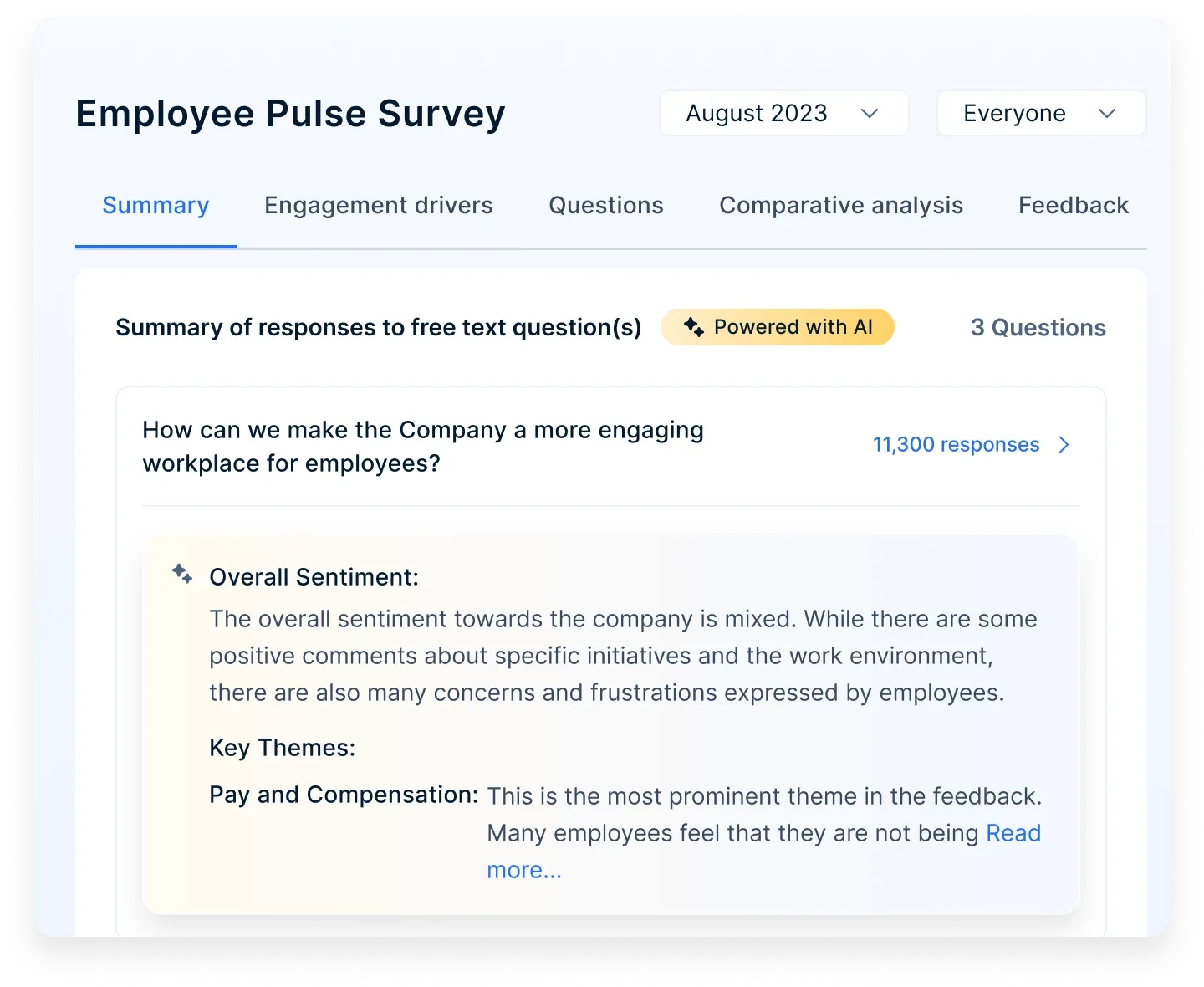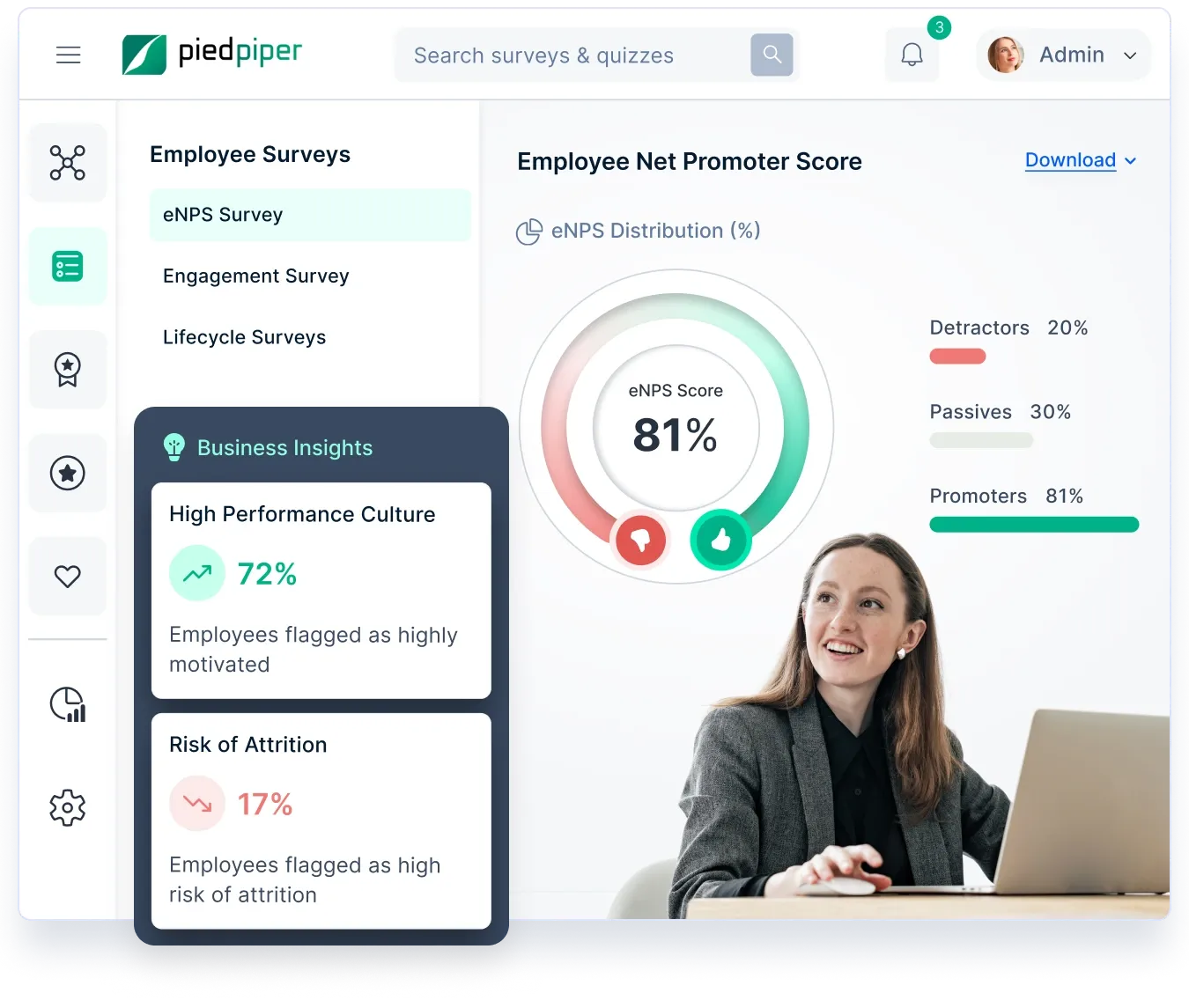Indagini sulla soddisfazione dei dipendenti: Come misurare e migliorare la felicità sul posto di lavoro
Un sondaggio sulla soddisfazione dei dipendenti ben strutturato aiuta a misurare la felicità dell'ambiente di lavoro, a identificare i problemi e a promuovere i miglioramenti. Questa guida tratta di tutto, dalla creazione delle domande all'analisi dei feedback per una forza lavoro più coinvolta.
In questa pagina
- Che cos'è un sondaggio sulla soddisfazione dei dipendenti?
- Perché l'indagine sulla soddisfazione dei dipendenti è importante?
- Perché le aziende devono condurre un'indagine sulla soddisfazione dei dipendenti?
- Fattori che contribuiscono alla soddisfazione dei dipendenti
- Come misurare la soddisfazione dei dipendenti
- Come condurre un'indagine sulla soddisfazione dei dipendenti che fornisca informazioni utili per il futuro
- Esempi di domande per il sondaggio sulla soddisfazione dei dipendenti
- 30 Ulteriori domande del sondaggio sulla soddisfazione dei dipendenti da includere
- Come si fa a mantenere i dipendenti soddisfatti sul lavoro?
- Empuls: Il modo intelligente di condurre indagini sulla soddisfazione dei dipendenti
- Conclusione
- Domande frequenti
I vostri dipendenti apprezzano davvero il loro lavoro o date per scontato che siano soddisfatti? Molte organizzazioni trascurano l'importanza di raccogliere un vero feedback dai dipendenti, perdendo così opportunità di miglioramento. Senza indagini strutturate sulla soddisfazione dei dipendenti, le aziende rischiano un basso coinvolgimento, un elevato turnover e un calo della produttività.
Un'indagine sulla soddisfazione lavorativa dei dipendenti ben progettata aiuta a scoprire cosa funziona, cosa deve essere migliorato e come i dipendenti si sentono veramente nei confronti del loro ruolo, della leadership e della cultura del luogo di lavoro. La comprensione di queste informazioni consente alle organizzazioni di migliorare la fidelizzazione, aumentare il coinvolgimento e creare una forza lavoro più motivata.
Ma come condurre un'indagine sulla soddisfazione dei dipendenti che dia risultati significativi? Questa guida vi guiderà in tutto e per tutto, dall'ideazione delle domande giuste all'analisi delle risposte, fino all'adozione di misure attuabili per costruire un ambiente di lavoro più felice e impegnato.
Che cos'è un sondaggio sulla soddisfazione dei dipendenti?
I sondaggi sulla soddisfazione dei dipendenti sono concepiti per determinare il grado di soddisfazione o insoddisfazione dei dipendenti della vostra azienda e del loro lavoro.
Chiedere direttamente e regolarmente un feedback ai dipendenti è il modo migliore per ottenere queste informazioni: se non lo chiedete, non ve lo diranno. Il processo delle indagini sulla soddisfazione dei dipendenti ha lo scopo di colmare questa lacuna.
Inviate regolarmente un sondaggio anonimo a tutti i vostri dipendenti - ogni mese, ogni trimestre o ogni anno - e chiedete loro cosa va bene e cosa potrebbe essere migliorato.
Esistono molti modi diversi per organizzare un sondaggio sulla soddisfazione dei dipendenti. Alcune organizzazioni effettuano frequenti e brevi sondaggi d'opinione per valutare le opinioni durante l'anno.
Molti datori di lavoro fanno un'unica grande indagine completa una volta all'anno. Alcuni combinano questi due metodi. Si tratta di scegliere quello che funziona meglio per la vostra azienda e per i vostri dipendenti.
Perché l'indagine sulla soddisfazione dei dipendenti è importante?
È facile per dirigenti e manager dare per scontato che i dipendenti siano soddisfatti. Dopo tutto, si offre loro un buon lavoro e una retribuzione e dei benefit decenti. Sembra che dovrebbe essere sufficiente.
Ma per le persone di livello superiore è difficile sapere cosa piace e cosa non piace alla maggior parte dei dipendenti. Potrebbero esserci molti fattori che non conoscete e che contribuiscono alla loro insoddisfazione, oppure cose che ritenete minori e che invece causano una grande felicità dei dipendenti. grande felicità dei dipendenti.
Le congetture o le supposizioni non vi daranno queste risposte. Ma un'indagine ben progettata sui dipendenti sì. E chiedere la soddisfazione dei dipendenti non è solo un esercizio di benessere.
Avere dipendenti felici e impegnati comporta enormi vantaggi per l'azienda.
Secondo una ricerca dell'Università di Warwick, i dipendenti felici hanno maggiori probabilità di essere produttivi e impegnati. 12% più produttivi.
Questo può fare la differenza tra avere un anno di risultati commerciali regolari e superare tutte le aspettative.
Perché le aziende devono condurre un'indagine sulla soddisfazione dei dipendenti?
Potrebbe venirvi in mente la domanda "perché fare un sondaggio sulla soddisfazione dei dipendenti". Ecco alcuni importanti vantaggi che indagini sul coinvolgimento dei dipendenti apportano a un'organizzazione.
1. Aumenta il coinvolgimento dei dipendenti
È facile rimanere bloccati in una routine lavorativa ed entrare in uno spazio in cui i dipendenti si sentono come se avessero il pilota automatico. In questo caso, è facile trascurare il loro impegno. Tuttavia, non bisogna permettere che ciò accada.
I dipendenti impegnati si impegneranno al massimo per raggiungere gli obiettivi del loro ruolo. Pertanto, è necessario assicurarsi che siano impegnati.
Condurre regolarmente sondaggi sulla soddisfazione dei dipendenti consente alle aziende di conoscere le opinioni e i pareri dei loro collaboratori sul posto di lavoro. Apportando attivamente dei miglioramenti, dimostrate ai vostri dipendenti che apprezzate il loro feedback.
La semplice conduzione di sondaggi e la presa in considerazione dei pensieri e delle opinioni dei dipendenti possono fare miracoli per mantenerli impegnati. Contribuirà a farli sentire valorizzati e apprezzati, per ottenere una visione più positiva dell'azienda. Aumentando il livello di coinvolgimento dei dipendenti si può incrementare la loro produttività del 20%.!
2. Permette una migliore comprensione
Avete pensato a come si sentono i dipendenti?
Quali sono i loro atteggiamenti (sia positivi che negativi)?
Cosa pensano dei cambiamenti avvenuti?
Sono d'accordo o in disaccordo con loro?
Indagini regolari sulla soddisfazione dei dipendenti possono tracciare e valutare questi sentimenti e sensazioni nel tempo. In questo modo, la direzione può valutare come vengono soddisfatte le esigenze dei dipendenti.
3. Approfondimenti sulla crescita delle organizzazioni
I sondaggi consentono di determinare meglio il percorso di crescita organizzativa. Ad esempio, danno alle aziende la possibilità di valutare aspetti quali:
- ➡ Fornire ai dipendenti gli strumenti adeguati per svolgere il proprio lavoro.
- ➡ L'efficacia delle strutture di leadership
- ➡ La salute della salute della cultura aziendale e dove può essere migliorata.
Un ulteriore passo avanti permette di capire meglio come funzionano i vari reparti e il sentimento che circonda quello specifico reparto rispetto agli altri.
Se alcune parti funzionano bene, pensate a come massimizzare questi punti positivi in altri reparti.
4. Permette ai dipendenti di essere ascoltati
Ci vuole un dipendente volitivo per esprimere i propri sentimenti. A volte, essere brutalmente onesti con un manager può non piacere, e allora il dipendente rischia di essere frainteso.
Il sondaggio consente ai dipendenti di avere una piattaforma dove poter esprimere liberamente le proprie opinioni in uno spazio sicuro. I sondaggi anonimi sono un modo eccellente per ottenere informazioni più profonde e oneste.
Questo perché i dipendenti sanno che non subiranno alcuna ripercussione se esprimeranno le loro opinioni.
"L'uomo è meno se stesso quando parla in prima persona. Dategli una maschera e vi dirà la verità". - Oscar Wilde.
5. Prevede e riduce il turnover dei dipendenti
Gli alti tassi di turnover dei dipendenti sono una preoccupazione per le aziende, perché hanno ripercussioni sul tempo e sul denaro investito nei dipendenti. I sondaggi forniscono indicazioni preziose su come limitare il numero di dipendenti che pensano di andarsene.
Porre le domande giuste consente di ottenere un quadro chiaro di quanto i dipendenti siano soddisfatti del proprio lavoro. Può anche evidenziare ciò che i dipendenti desiderano e di cui hanno bisogno in termini di carriera nel lungo periodo.
Fattori che contribuiscono alla soddisfazione dei dipendenti
Analizziamo alcuni fattori di soddisfazione dei dipendenti:
1. Stabilità finanziaria e stipendio
Per i dipendenti, tutto ciò che riguarda la soddisfazione lavorativa potrebbe passare in secondo piano rispetto alla consapevolezza che l'azienda per cui lavorano non fallirà presto. La sicurezza finanziaria toglie molto stress alle persone.
È quindi logico che questo sia uno dei fattori che più contribuiscono alla soddisfazione dei dipendenti. Per coloro che non si sentono a proprio agio in questo senso, un sondaggio sulla soddisfazione dei dipendenti potrebbe essere una piattaforma in cui affrontare questi argomenti scomodi.
2. Apprezzamento
Se i dipendenti non si sentono valorizzati e apprezzati, si può essere certi che ciò influirà sulla loro produttività. Non solo, ma ben il 79% dei dipendenti che si sono licenziati dichiara che uno dei motivi principali è la mancanza di apprezzamento.
Non tutti i dipendenti si sentiranno sempre abbastanza sicuri o liberi da parlare apertamente di sentirsi sottovalutati.
Può capitare che pensino che il loro duro lavoro sia passato inosservato. Un semplice "grazie" è molto utile per far sì che i vostri dipendenti si sentano apprezzati e stimati.
3. Buone relazioni con i colleghi e la direzione
Spesso i cattivi rapporti con i colleghi o i dirigenti possono rendere un po' più difficile affrontare la giornata lavorativa. In molti casi, la sgradevolezza può essere risolta attraverso una una comunicazione efficace.
Forse anche qualche attività di team building o un pranzo settimanale di gruppo? Avere buoni rapporti di lavoro contribuisce alla soddisfazione dei dipendenti in molti modi.
Questo li fa sentire meglio quando vanno al lavoro, aumenta la produttività e il morale e contribuisce a creare un ambiente di lavoro più positivo.
4. Equilibrio tra lavoro e vita privata
È naturale che i dipendenti si sentano sopraffatti se hanno l'impressione che il loro carico di lavoro sia eccessivo e che stiano lavorando per molte ore. I dipendenti non vogliono che il loro lavoro diventi il centro della loro vita.
Vogliono passare del tempo con la famiglia e gli amici e avere tempo per i loro hobby e per le altre cose che amano. Questo è particolarmente vero quando quando si tratta di millennial.
5. Sviluppo della carriera
Come incentivo, l'apprendimento e lo sviluppo della carriera sono considerati fattori importanti quando si guarda alla soddisfazione dei dipendenti. I dipendenti vogliono sapere che l'azienda per cui lavorano ha un forte interesse a far progredire la loro carriera.
Le aziende offrono loro l'opportunità di apprendere nuove competenze o di sviluppare quelle in cui sono bravi e appassionati? Anche questo aspetto è importante per capire quanto i dipendenti siano disposti a dare di più se sentono di essere investiti regolarmente.
Come misurare la soddisfazione dei dipendenti
La misurazione della soddisfazione dei dipendenti va oltre le supposizioni: richiede un feedback strutturato, un'analisi dei dati e un miglioramento continuo. Ecco i modi più efficaci per valutare la reale soddisfazione dei vostri dipendenti:
1. Conduzione di indagini sulla soddisfazione dei dipendenti
Un sondaggio sulla soddisfazione dei dipendenti ben fatto è uno dei modi più affidabili per misurare la felicità sul posto di lavoro. Utilizzate un mix di domande quantitative (scale di valutazione, a scelta multipla) e qualitative (a risposta aperta) per ottenere una visione completa. Alcune aree chiave da coprire sono:
- Soddisfazione per il ruolo lavorativo
- Equilibrio tra lavoro e vita privata
- Supporto alla gestione
- Opportunità di crescita professionale
2. Utilizzare sondaggi sulla soddisfazione lavorativa dei dipendenti nei punti di contatto chiave.
Un solo sondaggio non è sufficiente. Conducete indagini sulla soddisfazione lavorativa dei dipendenti in diverse fasi del loro ciclo di vita, come ad esempio:
- Indagini di onboarding - Valutare le prime impressioni dei nuovi assunti.
- Indagini trimestrali o annuali sul coinvolgimento - Tracciare le tendenze a lungo termine.
- Indagini di uscita - Per capire perché i dipendenti lasciano e come migliorare la fidelizzazione.
3. Sfruttare i sondaggi per un feedback continuo
Sondaggi regolari offrono informazioni in tempo reale sul sentimento dei dipendenti. Indagini brevi e frequenti aiutano a identificare i problemi emergenti prima che si aggravino, rendendo più facile l'implementazione di miglioramenti tempestivi.
4. Analizzare eNPS (employee net promoter score)
L'eNPS misura la probabilità che i dipendenti raccomandino l'azienda come un ottimo posto di lavoro. Le risposte vengono classificate in Promotori (9-10), Passivi (7-8) e Detrattori (0-6) per fornire una rapida istantanea della soddisfazione complessiva.
5. Monitorare le metriche di coinvolgimento sul posto di lavoro
Tracciate i tassi di fidelizzazione dei dipendenti, l'assenteismo e i livelli di produttività per identificare le tendenze di fondo della soddisfazione. Un elevato turnover e assenze frequenti sono spesso segnali di disimpegno e insoddisfazione.
6. Effettuare controlli individuali e colloqui di permanenza.
Le conversazioni personali con i dipendenti forniscono una visione più approfondita delle loro preoccupazioni, delle loro motivazioni e dell'esperienza lavorativa complessiva. Colloqui periodici sulla permanenza aiutano a identificare ciò che mantiene i dipendenti impegnati e ciò che potrebbe spingerli ad andarsene.
7. Incoraggiare un feedback aperto attraverso canali anonimi
I dipendenti possono esitare a condividere direttamente opinioni oneste. Fornendo strumenti di feedback anonimi, si garantisce che si sentano sicuri nell'esprimere le loro preoccupazioni, ottenendo così informazioni più accurate sulla soddisfazione sul posto di lavoro.
La misurazione della soddisfazione dei dipendenti non è un processo una tantum: richiede feedback, analisi e azioni continue. Utilizzando una combinazione di sondaggi, metriche di coinvolgimento e conversazioni dirette, le organizzazioni possono costruire una cultura dell'ambiente di lavoro che valorizzi e dia priorità al benessere dei dipendenti.

Misurare e migliorare la soddisfazione dei dipendenti con Empuls
Scoprite i dati reali dei dipendenti con lo strumento di indagine sulla soddisfazione dei dipendenti di Empuls. Create sondaggi personalizzabili, raccogliete feedback onesti e intraprendete azioni basate sui dati per aumentare la felicità e la fidelizzazione sul posto di lavoro.
Come condurre un'indagine sulla soddisfazione dei dipendenti che fornisca informazioni utili per il futuro
Un sondaggio sulla soddisfazione dei dipendenti ben eseguito va oltre la raccolta delle risposte: deve rivelare il reale sentimento dell'ambiente di lavoro e portare a miglioramenti misurabili. Ecco come strutturare ed eseguire un sondaggio che fornisca informazioni preziose piuttosto che semplici dati.
1. Definire un obiettivo chiaro
Prima di formulare le domande, stabilite cosa volete misurare. State valutando la soddisfazione lavorativa complessiva, identificando le ragioni del turnover o valutando l'efficacia della leadership? Un sondaggio privo di un obiettivo chiaro porterà a intuizioni frammentarie su cui è difficile intervenire.
2. Utilizzare un mix di tipi di domande
Evitate i sondaggi che si basano esclusivamente su scale di valutazione. Piuttosto, bilanciate domande quantitative (scala Likert, scelta multipla) e qualitative (domande aperte) per cogliere sia le tendenze che gli approfondimenti. Esempi:
- Su una scala da 1 a 10, quanto è soddisfatto delle sue opportunità di crescita professionale?
- Qual è una cosa che l'azienda potrebbe fare per migliorare la vostra esperienza lavorativa?
3. Mantenere il testo conciso ma completo
Un sondaggio che richiede più di 10 minuti per essere completato rischia di avere una scarsa partecipazione. Puntate su 15-20 domande mirate che coprano aree chiave come:
- Soddisfazione lavorativa e chiarezza di ruolo
- Efficacia della leadership e della gestione
- Equilibrio tra lavoro e vita privata e flessibilità
- Opportunità di crescita e apprendimento
- Riconoscimento e cultura del lavoro
4. Garantire l'anonimato per un feedback onesto
Se i dipendenti temono un contraccolpo, forniranno risposte diplomatiche anziché vere e proprie intuizioni. Utilizzate uno strumento di indagine anonimo per garantire la riservatezza e comunicatelo chiaramente nelle istruzioni dell'indagine.
5. Scegliere i tempi e la frequenza giusti
- I sondaggi trimestrali funzionano bene per monitorare le tendenze del coinvolgimento.
- Le indagini annuali approfondite forniscono informazioni esaurienti, ma richiedono forti azioni di follow-up.
- I sondaggi di uscita rilevano i motivi per cui i dipendenti se ne vanno e come migliorare le strategie di retention.
6. Promuovere la partecipazione con una comunicazione trasparente
I bassi tassi di risposta spesso derivano da una scarsa comunicazione. Per aumentare la partecipazione:
- Spiegate perché il sondaggio è importante e come verrà utilizzato il feedback.
- Ottenere il consenso della leadership: quando i dirigenti incoraggiano la partecipazione, è più probabile che i dipendenti si impegnino.
- Inviate dei promemoria, ma evitate di dare un seguito eccessivo che dia l'impressione di essere invadente.
7. Agire sul feedback e chiudere il cerchio
L'errore più grande che le aziende commettono è quello di raccogliere dati ma di non agire di conseguenza. Dopo aver analizzato i risultati:
- Condividete i risultati di alto livello con i dipendenti: la trasparenza crea fiducia.
- Date priorità alle aree di intervento principali, anziché cercare di risolvere tutto in una volta.
- Assegnare la responsabilità ai team HR o di leadership per implementare i miglioramenti.
- Seguite i dipendenti per mostrare cosa viene cambiato in base al loro feedback.
8. Misurare l'impatto nel tempo
Un sondaggio una tantum non risolverà i problemi di coinvolgimento. Confrontate i risultati nel tempo per valutare se i cambiamenti stanno funzionando. Se i punteggi rimangono stagnanti, perfezionate le domande del sondaggio o esplorate altre strategie di coinvolgimento.
Se condotta correttamente, un'indagine sulla soddisfazione dei dipendenti diventa un potente strumento decisionale che aiuta le aziende a trattenere i talenti, ad aumentare il morale e a creare una fiorente cultura dell'ambiente di lavoro.
Esempi di domande per il sondaggio sulla soddisfazione dei dipendenti
Ora che sapete cosa sono i sondaggi sulla soddisfazione dei dipendenti, perché sono fondamentali per il successo della vostra azienda e quali sono i fattori che rendono veramente soddisfatti i dipendenti, potete pensare di creare il vostro sondaggio sulla soddisfazione dei dipendenti.
È possibile trovare numerosi esempi di domande di sondaggio sulla soddisfazione dei dipendenti: SHRM ha un modello prezioso per creare il vostro sondaggio. Il Gallup a 12 domande è molto utilizzato da molte aziende per misurare il coinvolgimento e la soddisfazione.
Se siete alla ricerca di una soluzione completa per il coinvolgimento dei dipendenti, potete lavorare con un sistema che crei un sondaggio per voi, come ad esempio Empuls.
Volete maggiori indicazioni sulle domande per un sondaggio sulla soddisfazione dei dipendenti? Ecco alcuni suggerimenti per iniziare.
1. Siete ispirati dalla missione e dallo scopo della nostra azienda?
Ai dipendenti piace lavorare in un posto con valori forti e una missione chiara, che si tratti di fare del bene al mondo o di servire i clienti con eccellenza e integrità.
Allora, come si comporta la vostra azienda?
2. Vedete un percorso di avanzamento e di crescita della vostra carriera con noi?
Anche se ai dipendenti piace lavorare nella vostra azienda, non rimarranno soddisfatti se non vedono un percorso di crescita a lungo termine. Secondo una ricerca di Deloitte, se ne andranno: la mancanza di opportunità di sviluppo professionale è il motivo principale per cui i vostri dipendenti lasciano l'azienda. Quindi, misurare il vostro operato in quest'area è molto importante.
3. Vi piace la nostra cultura aziendale?
Forse avete lavorato duramente per creare una cultura consapevole e chiara nel vostro ambiente di lavoro, o forse non sapete da dove cominciare.
Chiedere ai dipendenti se apprezzano la cultura dell'ambiente di lavoro è un buon modo per iniziare a creare una forza lavoro sana e felice.
4. Trova che il suo lavoro sia significativo?
Tutti noi vogliamo fare un lavoro che non sia solo un elenco di cose da fare, ma che abbia un vero significato. I vostri dipendenti avranno definizioni diverse del significato del loro lavoro, ma chiedere loro se ritengono che il loro lavoro sia importante in qualche modo è un buon modo per misurare l'impegno e la felicità.
In effetti, la capacità di svolgere un lavoro significativo è così vitale per i dipendenti che 9 persone su 10 intervistate dai ricercatori accetterebbe una significativa riduzione dello stipendio per svolgere un lavoro più importante per loro.
5. Come giudica il suo equilibrio tra lavoro e vita privata?
L'equilibrio tra lavoro e vita privata è fondamentale per avere dipendenti felici e produttivi. Il burnout dovuto al fatto di non avere abbastanza tempo libero o di lavorare sempre a lungo fa diminuire la soddisfazione. Il 53% dei dipendenti dichiara che l'equilibrio tra lavoro e vita privata è fondamentale per loro.
Potreste avere una politica di ferie generosa, ma quanto la cultura aziendale e il management incoraggiano la fruizione del tempo libero?
6. La nostra azienda vi fornisce gli strumenti e le tecnologie per svolgere bene il vostro lavoro?
Se avete dipendenti che amano il loro lavoro e sono bravissimi, ma non date loro gli strumenti essenziali per svolgerlo, saranno frustrati e infelici. Può trattarsi della mancanza di software o computer aggiornati o di altri elementi necessari per svolgere il proprio lavoro.
7. Quanto è soddisfatto del suo lavoro?
Se volete sapere se i vostri dipendenti sono felici sul lavoro, chiedete loro se sono felici! È semplice ma efficace chiedere direttamente il loro livello di soddisfazione.
8. Vi sentite apprezzati per il vostro contributo?
Riconoscere e apprezzare il contributo il contributo dei vostri dipendenti all'azienda ogni giorno sembra così elementare, ma molti leader e manager non lo considerano una priorità.
Utilizzate questa domanda per verificare come la vostra cultura tratta il riconoscimento dei dipendenti e se i dipendenti sentono che il loro lavoro è apprezzato. In caso contrario, avete del lavoro da fare.

Ottenete modelli di indagine sulla soddisfazione dei dipendenti pronti per l'uso
Risparmiate tempo e raccogliete feedback significativi con i modelli di sondaggio progettati da esperti di Empuls. Scegliete tra i modelli personalizzabili per misurare la soddisfazione dei dipendenti, l'impegno e la cultura del luogo di lavoro senza sforzo.
30 Ulteriori domande del sondaggio sulla soddisfazione dei dipendenti da includere
Un sondaggio sulla soddisfazione dei dipendenti ben strutturato dovrebbe coprire diversi aspetti dell'esperienza sul posto di lavoro. Ecco 30 domande attentamente classificate per garantire una comprensione completa del sentiment dei dipendenti.
Domande del sondaggio sulla soddisfazione lavorativa e sulla chiarezza del ruolo dei dipendenti
Capire come i dipendenti percepiscono i loro ruoli e le loro responsabilità è fondamentale per mantenere il coinvolgimento e la produttività. Queste domande valutano se i dipendenti trovano il loro lavoro appagante, in linea con le loro competenze e chiaramente definito.
- Quanto è soddisfatto del suo attuale ruolo e delle sue responsabilità?
- Avete una chiara comprensione delle aspettative e degli obiettivi del vostro lavoro?
- Ritenete che il vostro lavoro contribuisca in modo significativo al successo dell'azienda?
- Siete entusiasti dei vostri compiti e progetti quotidiani?
Domande del sondaggio tra i dipendenti sulla cultura e sull'ambiente di lavoro
Una cultura positiva dell'ambiente di lavoro favorisce la collaborazione, la fiducia e l'inclusione. Queste domande aiutano a capire se i dipendenti si sentono apprezzati, sostenuti e a proprio agio nel loro ambiente di lavoro.
- Come descriverebbe la cultura lavorativa complessiva dell'organizzazione?
- Vi sentite inclusi e rispettati come parte del vostro team?
- Quanto vi sentite a vostro agio nel condividere idee e preoccupazioni sul lavoro?
- L'azienda promuove un forte equilibrio tra lavoro e vita privata?
Domande del sondaggio tra i dipendenti su leadership e gestione
Una leadership efficace svolge un ruolo significativo nel coinvolgimento e nella soddisfazione dei dipendenti. Queste domande valutano la capacità di manager e leader di sostenere, comunicare e guidare i propri team.
- Quanto efficacemente il vostro manager fornisce feedback e indicazioni?
- Vi sentite a vostro agio nell'esporre le vostre preoccupazioni al vostro responsabile?
- Ritenete che la leadership sia trasparente riguardo agli obiettivi e alle decisioni dell'azienda?
- Quanto spesso ricevete riconoscimenti e apprezzamenti dal vostro manager?
Domande del sondaggio tra i dipendenti su retribuzione e benefit
Retribuzione e benefit equi hanno un impatto diretto sulla motivazione e sulla fidelizzazione dei dipendenti. Queste domande valutano se i dipendenti si sentono adeguatamente compensati e supportati con vantaggi e incentivi.
- Ritiene che il suo stipendio rifletta in modo equo il suo contributo e le sue responsabilità?
- È soddisfatto dei benefit offerti dall'azienda (assistenza sanitaria, bonus, ferie pagate, ecc.)?
- Come giudica i programmi di ricompensa e riconoscimento dell'azienda?
- Ritiene che l'azienda fornisca incentivi finanziari in linea con le sue prestazioni?
Domande del sondaggio tra i dipendenti sulla crescita e lo sviluppo della carriera
I dipendenti vogliono sentire di avere spazio per crescere all'interno di un'organizzazione. Queste domande analizzano se i dipendenti si sentono supportati nel loro sviluppo professionale e nella progressione di carriera.
- Avete opportunità di apprendimento e di avanzamento di carriera?
- Ritiene che l'azienda investa nella sua crescita professionale?
- Esistono percorsi chiari per la progressione di carriera all'interno dell'azienda?
- Quanto spesso ricevete un feedback costruttivo che vi aiuta a migliorare?
Domande del sondaggio tra i dipendenti su carico di lavoro e produttività
La gestione del carico di lavoro influisce direttamente sui livelli di stress e di impegno dei dipendenti. Queste domande valutano se i dipendenti si sentono supportati nel mantenere un flusso di lavoro equilibrato e produttivo.
- Ritiene che il suo carico di lavoro sia ragionevole e gestibile?
- Quanto spesso sperimenta stress o burnout a causa del lavoro?
- Vi vengono forniti gli strumenti e le risorse necessarie per svolgere il vostro lavoro in modo efficiente?
- Il vostro team collabora efficacemente per raggiungere gli obiettivi condivisi?
Domande del sondaggio sull'impegno e la motivazione dei dipendenti
Capire cosa motiva i dipendenti può aiutare le aziende a creare una forza lavoro ad alto rendimento. Queste domande valutano i livelli di coinvolgimento e i fattori che determinano l'entusiasmo sul posto di lavoro.
- Vi sentite motivati a dare il meglio di voi stessi ogni giorno?
- L'azienda promuove un ambiente che incoraggia l'innovazione e la creatività?
- Vi sentite riconosciuti per il vostro contributo?
- Quanto è soddisfatto del livello di autonomia del suo ruolo?
Domande del sondaggio tra i dipendenti sulla comunicazione e la trasparenza dell'azienda
Una comunicazione chiara crea fiducia e rafforza l'impegno dei dipendenti. Queste domande misurano quanto i dipendenti comprendano gli obiettivi aziendali e si sentano informati sulle decisioni aziendali.
- Vi sentite informati sugli aggiornamenti aziendali e sui cambiamenti strategici?
- Quanto è trasparente la leadership nel comunicare le decisioni aziendali importanti?
Un sondaggio ben strutturato sulla soddisfazione dei dipendenti deve affrontare i fattori chiave che influiscono sulla felicità del posto di lavoro, tra cui la chiarezza del ruolo, la cultura, la leadership, la retribuzione e le opportunità di crescita. La raccolta regolare di feedback aiuta le aziende ad apportare miglioramenti basati sui dati e a migliorare l'esperienza complessiva dei dipendenti.
Come si fa a mantenere i dipendenti soddisfatti sul lavoro?
Questi sono solo alcuni esempi di domande che potete includere nel vostro sondaggio sulla soddisfazione dei dipendenti. Sarebbe meglio dare priorità alle domande che si collegano agli obiettivi aziendali o alle aree che si sta cercando di migliorare.
Su quali aree è importante concentrarsi?
Ecco le principali categorie che contribuiscono alla soddisfazione dei dipendenti:
1. La cultura
La cultura del vostro posto di lavoro è fondamentale per la felicità dei dipendenti. Avete creato un ambiente pieno di competitività, stress e sovraccarico di lavoro? Oppure siete in procinto di creare una cultura in cui i dipendenti si sentano sicuri, apprezzati e stimolati a crescere?
La cultura del vostro posto di lavoro può avere una chiara missione guida o essere composta da norme non dichiarate. Ma di sicuro ne avete una, quindi lavorate per assicurarvi che sia positiva.
2. Collaboratori
Avete un migliore amico al lavoro? I vostri dipendenti potrebbero averlo, e questa è una cosa fantastica. Porta a il doppio del livello di coinvolgimento se ce l'avete. Se ci pensate, passiamo più tempo con i nostri colleghi che con la maggior parte delle altre persone della nostra vita.
È quindi logico che avere colleghi di cui ci si fida, che piacciono e che si rispettano sia fondamentale per la felicità dei dipendenti. State assumendo persone che creano questo ambiente positivo?
3. Rapporto con il manager
I manager hanno un impatto significativo sulle parti vitali dell'esperienza dei dipendenti: il tipo di lavoro che i dipendenti possono svolgere, il loro percorso di carriera e la loro esperienza quotidiana sul lavoro.
4. L'autonomia
Quando si assumono le persone migliori, si vuole avere fiducia che facciano bene il loro lavoro. Il micromanagement è frustrante per i dipendentisoprattutto per i vostri top performer che sono bravissimi nel loro lavoro.
Permettete ai dipendenti di avere autonomia e proprietà sul loro lavoro? Questo porta a una maggiore soddisfazione e felicità.
Empuls: Il modo intelligente di condurre indagini sulla soddisfazione dei dipendenti

Capire il sentiment dei dipendenti è fondamentale per promuovere una cultura del lavoro positiva. Lo strumento di Empulsstrumento di indagine sulla soddisfazione dei dipendenti semplifica la raccolta, l'analisi e l'azione dei feedback dei dipendenti, assicurando che le organizzazioni rimangano in contatto con la loro forza lavoro.
Perché utilizzare Empuls per le indagini sulla soddisfazione dei dipendenti?
- Modelli pronti all'uso e sondaggi personalizzati - Scegliete tra i modelli progettati da esperti o create i vostri per porre le domande giuste.
- Sondaggi automatizzati su impulsi e ciclo di vita - Acquisizione di feedback in tempo reale nelle diverse fasi del percorso dei dipendenti, dall'inserimento all'uscita.
- Approfondimenti basati sull'intelligenza artificiale per decisioni più intelligenti - Identificate le principali tendenze di coinvolgimento, scoprite i fattori di disimpegno nascosti e agite sulla base dei dati.
- Raccolta e condivisione dei feedback senza problemi - Distribuite facilmente i sondaggi tramite Slack, Microsoft Teams o e-mail, rendendo la partecipazione semplice.
- Risposte riservate e prive di pregiudizi - Incoraggiate un feedback onesto con opzioni di indagine anonime che creano fiducia e trasparenza.
Con Empuls, le organizzazioni possono andare oltre la semplice misurazione della soddisfazione: possono riconoscere i risultati ottenuti, aumentare il coinvolgimento e creare un ambiente di lavoro fiorente.
Conclusione
Un'indagine sulla soddisfazione dei dipendenti ben strutturata è più di un semplice strumento di feedback: è un approccio strategico per migliorare la cultura dell'ambiente di lavoro, aumentare il coinvolgimento e trattenere i migliori talenti. Capire come condurre un'indagine sulla soddisfazione dei dipendenti assicura alle organizzazioni la raccolta di informazioni accurate e attuabili che portano a miglioramenti significativi.
Progettando il giusto sondaggio sulla soddisfazione dei dipendenti e promuovendo un ambiente in cui i dipendenti si sentano ascoltati, le aziende possono identificare i principali fattori di coinvolgimento, affrontare le problematiche del luogo di lavoro e migliorare la produttività complessiva.
Tuttavia, la raccolta di feedback è solo il primo passo: agire in base ai risultati del sondaggio è ciò che rafforza veramente la fiducia, la motivazione e l'impegno a lungo termine.
Quando le organizzazioni danno priorità alla soddisfazione dei dipendenti, creano una cultura in cui questi ultimi sono più impegnati, produttivi e investiti nel successo aziendale.
Domande frequenti
1. Qual è lo scopo di un sondaggio sulla soddisfazione dei dipendenti?
Un sondaggio sulla soddisfazione dei dipendenti è progettato per valutare quanto i dipendenti si sentano soddisfatti e appagati nel loro ruolo e all'interno dell'organizzazione. Lo scopo principale è quello di raccogliere informazioni utili per migliorare la cultura dell'ambiente di lavoro, il coinvolgimento e la fidelizzazione.
Misurando i livelli di soddisfazione in aree come le responsabilità lavorative, la leadership, la retribuzione, la crescita professionale e l'ambiente di lavoro, le aziende possono identificare i punti dolenti, affrontare i problemi e creare strategie per migliorare l'esperienza dei dipendenti. Se condotte regolarmente, queste indagini aiutano le organizzazioni a migliorare il morale, a ridurre il turnover e a promuovere il successo aziendale a lungo termine.
2. Con quale frequenza devono essere condotte le indagini sulla soddisfazione dei dipendenti?
La frequenza dipende dalle esigenze dell'azienda. Le indagini annuali forniscono informazioni approfondite, mentre quelle trimestrali o di impulso tracciano le tendenze del coinvolgimento in tempo reale. I follow-up regolari garantiscono un miglioramento continuo.
3. Quali sono gli elementi chiave di un buon sondaggio sulla soddisfazione dei dipendenti?
Un'indagine ben progettata dovrebbe includere domande chiare e imparziali, un mix di risposte quantitative e qualitative, l'anonimato per un feedback onesto e follow-up attuabili in base ai risultati.
4. Qual è la differenza tra un sondaggio sulla soddisfazione dei dipendenti e un sondaggio sul coinvolgimento?
Le indagini sulla soddisfazione misurano la felicità sul posto di lavoro, la retribuzione e le condizioni di lavoro, mentre le indagini sul coinvolgimento valutano la motivazione, l'impegno e il legame emotivo con l'organizzazione.
5. Come possono le aziende agire sulla base dei risultati delle indagini sulla soddisfazione dei dipendenti?
Le organizzazioni devono analizzare le tendenze, identificare le criticità, comunicare i risultati in modo trasparente e attuare strategie per risolvere i problemi dei dipendenti. I cicli di feedback continui portano a miglioramenti reali.
6. Quali sono gli errori più comuni che le aziende dovrebbero evitare nelle indagini di soddisfazione?
Evitate sondaggi troppo lunghi, domande vaghe o provocatorie, la mancanza di anonimato e l'incapacità di dare seguito al feedback. Un sondaggio mal eseguito può portare al disimpegno e alla sfiducia nel processo.













